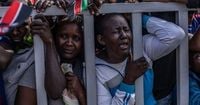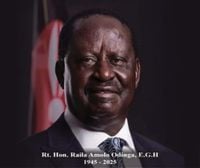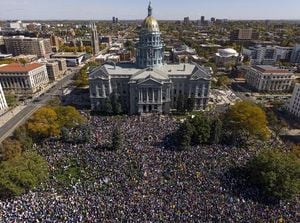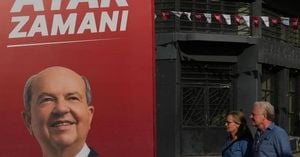Kenya has been gripped by a wave of grief and chaos following the death of former Prime Minister Raila Odinga, whose passing in India on October 15, 2025, at the age of 80, has triggered a series of tragic events during public mourning ceremonies. As thousands of devoted supporters flocked to pay their last respects to the veteran opposition leader, scenes of mourning quickly turned into moments of panic and heartbreak, leaving at least six people dead and hundreds more injured across several cities.
Odinga, a towering figure in Kenyan politics and a symbol of the nation’s struggle for democracy, died after collapsing during a morning walk in Kerala, India. Despite efforts to revive him at a local hospital, he did not survive, according to The Associated Press. His body was flown back to Kenya, arriving on October 16, and immediately drew massive crowds eager to honor a man celebrated for his activism and five presidential runs, even though he never clinched the highest office.
The first major tragedy struck during the initial public viewing of Odinga’s body at Moi International Sports Centre, Kasarani, in Nairobi on October 16. According to Nation Media, three people died and several others were injured when police fired live ammunition and tear gas into the crowd after mourners attempted to breach the pavilion where the casket was placed. The chaos sparked a stampede, sending people fleeing in all directions. Kenya’s chief of police operations, Adamson Bungei, confirmed, “We have at least two deaths for now,” characterizing the incident as a “confrontation.”
Doctors Without Borders (MSF) reported that on October 17 at Nyayo Stadium, another funeral venue in Nairobi, multi-agency teams treated 163 patients, referring 34 for further care. Most injuries involved blunt force trauma and fractures, and tragically, two more people died on the spot during a stampede that erupted shortly after dignitaries exited the state funeral service. The Standard newspaper reported that hundreds had been injured during these events, and the total number of casualties could rise as more information emerges.
Among the deceased at Kasarani Stadium were Vincent Oguttu, Evans Kichie, and Jidah Burka, the latter a 42-year-old father of three. “According to family members who we met at the City Mortuary this morning, Jidah was 42 years old and is survived by his wife and three children. The family wanted to get the body for burial immediately as Jidah is a Muslim, but they were compelled to wait until Tuesday,” Vocal Africa’s Chief Executive Director Hussein Khalid told Nation Media. Nairobi Funeral Home received five bodies from these tragic incidents, with three already identified.
In addition to the chaos in Nairobi, tragedy also struck in Homa Bay County. On the night of October 16, Lucy Oketch was fatally shot after closing her coffee vending business and heading home. Police reports indicate that tensions escalated outside the Homa Bay Police Station when some individuals began throwing stones at officers. In response, a constable fired his weapon into the air to disperse the advancing crowd, but Oketch was struck in the thigh and later succumbed to her injuries. Homa Bay County Police Commander Lawrence Koilem confirmed that a constable had been arrested over the shooting.
The violence and injuries did not go unnoticed by the nation’s leaders and Odinga’s family. During the state funeral, Odinga’s widow, Ida, pleaded for calm, urging Kenyans to mourn peacefully. His brother, Oburu, added, “Raila should not be teargassed in death. He has been teargassed enough when he was alive. Please let us not cause a situation where he is teargassed again.” Their appeals echoed throughout the stadium as dignitaries, including President William Ruto, paid tribute to Odinga’s legacy. Ruto described him as “a patriot and selfless statesman who contributed to the country’s stability.”
Despite the escalating violence, the outpouring of grief and support for Odinga was undeniable. Thousands of mourners, some trekking more than 18 miles, escorted his body from the main airport to the stadiums. In Kisumu, Odinga’s political heartland, heavy security was deployed ahead of the final public viewing at the soccer stadium on October 18. Military officers, police, and air surveillance teams were stationed throughout the city, as reported by the BBC and Reuters. Mourners camped overnight in anticipation of seeing Odinga one last time, but the event was again marred by injuries. Dozens were hurt, some critically, in a crush at the Jomo Kenyatta Stadium, forcing the cancellation of a planned road procession to Odinga’s rural home in Bondo. Instead, his body was to be flown directly to Bondo for burial on October 19.
Throughout the ordeal, hospitals across Nairobi and Kisumu were inundated with casualties. Kenyatta National Hospital received 34 patients from the incidents, with four still undergoing treatment as of October 18. One patient, Susan, told Nation Media, “I’m waiting to be taken to the theatre for an operation. I cannot tell whether it is bullets or rubber bullets. I sustained two shots; one in my thigh and my hand.” The Kenyan Red Cross and MSF worked tirelessly to treat the wounded, with emergency services stretched to their limits amid the chaos.
Odinga’s death and the subsequent turmoil have cast a spotlight on the passionate, sometimes volatile, relationship between Kenyan citizens and their political leaders. Odinga’s life was defined by resilience and an unwavering commitment to democracy, earning him praise from figures such as former U.S. President Barack Obama. He played a crucial role in guiding Kenya toward multiparty democracy, often facing arrest and persecution for his activism. Despite never winning the presidency, his influence on the nation’s political landscape was profound.
In the months leading up to his death, Odinga and President Ruto, once fierce rivals, had reached an agreement that resulted in opposition members being appointed to Cabinet positions, signaling a period of political reconciliation after years of tension and protest. The country’s leadership, while united in honoring Odinga’s legacy, now faces mounting questions about public safety, crowd control, and the use of force by police during national events.
As the nation prepares for Odinga’s burial in Bondo, western Kenya, on October 19, the hope among many is that the violence will subside and the focus will return to celebrating the life and achievements of a man who, in the words of his brother, “should not be teargassed in death.” Kenya mourns not only the loss of a political giant but also the lives cut short in the chaos of collective grief.





